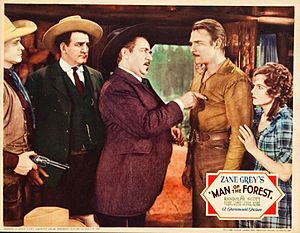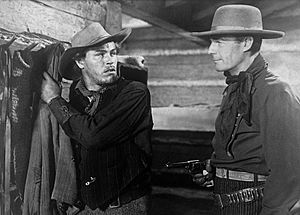Randolph Scott facts for kids
Quick facts for kids
Randolph Scott
|
|
|---|---|
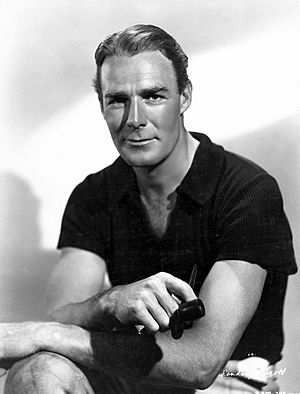
Scott in the early 1930s
|
|
| Born |
George Randolph Scott
January 23, 1898 Orange County, Virginia, U.S.
|
| Died | March 2, 1987 (aged 89) |
| Resting place | Elmwood Cemetery in Charlotte, North Carolina |
| Occupation | Actor |
| Years active | 1928–1962 |
| Spouse(s) |
Marion DuPont
(m. 1936; div. 1939)Patricia Stillman
(m. 1944) |
| Military career | |
| Allegiance | |
| Service/ |
|
| Years of service | 1917–1919 |
| Rank | |
| Unit | 2nd Trench Mortar Battalion |
| Battles/wars | World War I |
George Randolph Scott (born January 23, 1898 – died March 2, 1987) was an American actor. He starred in movies from 1928 to 1962. For most of his career, Scott played the main hero in films. He appeared in many types of movies, like dramas, comedies, musicals, and adventure stories.
However, Randolph Scott is best known for his roles as a Western hero. He was tall and often rode a horse in his films. Out of more than 100 movies he made, over 60 were Westerns. Many people think he was the star most connected to the Western movie style.
Scott worked with many famous directors during his 30 years as an actor. These included Henry Hathaway, Allan Dwan, and Budd Boetticher. He also acted alongside many well-known actresses, from Shirley Temple to Marlene Dietrich. His face was even used for the original pirate logo of the Las Vegas Raiders football team!
Scott was 6 feet 2 inches (188 cm) tall, strong, and good-looking. In his early movies, he had a relaxed charm and a Southern accent. As he got older, his acting improved. He often played a "strong, silent" hero who was brave and calm.
In the early 1950s, Randolph Scott was a very popular actor. Many people went to see his movies. He was ranked among the top ten movie stars from 1950 to 1953.
Early Life and Military Service
Randolph Scott was born in Orange County, Virginia. He grew up in Charlotte, North Carolina. He was the second of six children in his family. His parents were of Scottish background. His father, George Grant Scott, was the first certified public accountant (CPA) in North Carolina. His mother, Lucille Crane Scott, came from a wealthy family.
Because his family had money, Randolph went to private schools like Woodberry Forest School. From a young age, Scott was very athletic. He was excellent at football, baseball, horse racing, and swimming.
Serving in World War I
In April 1917, the United States joined World War I. In July, Scott joined the North Carolina National Guard. He learned to be an artillery observer, which means he helped direct cannon fire. He became a corporal in October 1917 and a sergeant in February 1918.
In May 1918, Scott began active duty in the Army. He went to France in June 1918 and fought in battles. After the war ended in November 1918, his unit helped occupy Germany.
Scott then went to Officer Candidate School in France. He became a second lieutenant in May 1919. He returned to the United States and was honorably discharged in June. Scott used his military experience in his acting. He was good at riding horses and using firearms.
After the War
After the war, Scott continued his education at Georgia Tech. He wanted to be an all-American football player. However, a back injury stopped him from reaching this goal.
Scott then moved to the University of North Carolina. He studied textile engineering. He later left college and worked as an accountant in a textile company, just like his father.
Acting Career Begins
Around 1927, Randolph Scott became interested in acting. He decided to go to Los Angeles to try to become a movie star. Scott's father knew Howard Hughes, a famous filmmaker. His father gave him a letter to introduce him to Hughes. Hughes helped Scott get a small part in a movie called Sharp Shooters (1928).
For the next few years, Scott worked as an extra or in small roles. He appeared in films like Weary River (1929) and The Virginian (1929). He even helped Gary Cooper with his accent in The Virginian.
Stage Acting Experience
Cecil B. DeMille, a famous director, advised Scott to get more acting experience on stage. Scott performed in plays at the Pasadena Playhouse. He played roles in plays like Julius Caesar by William Shakespeare.
In 1932, Scott acted in a play in Hollywood called Under a Virginia Moon. His performance led to offers from major movie studios. Scott signed a seven-year contract with Paramount Pictures. He earned $400 per week.
First Main Roles
In 1931, Scott played his first main role in a movie called Women Men Marry. This film is now lost. He then had a supporting role in A Successful Calamity (1932) for Warner Bros.
Becoming a Western Star
Paramount Pictures and Zane Grey Westerns
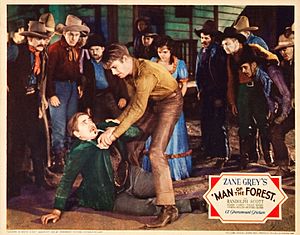
Scott's first role under his new Paramount contract was a small part in a comedy called Sky Bride (1932). After that, Paramount gave him the lead role in Heritage of the Desert (1932). This movie was very important because it made him a Western hero. Henry Hathaway directed this film, his first time as a director.
Heritage of the Desert was popular. Scott went on to make ten "B" Western films based on the novels of Zane Grey. These movies were often remakes of older silent films. To save money, Paramount used old footage and even some of the same actors.
Between his Zane Grey Westerns, Scott also acted in other types of movies. He was in a horror film called Murders in the Zoo (1933) and a romantic comedy.
Film experts say the Zane Grey movies were "uniformly good." They were also great for Scott because they helped him learn a lot about acting and action scenes.
Big Studio Films
Paramount loaned Scott to RKO Radio Pictures for Roberta (1935). This was a very popular musical starring Fred Astaire and Ginger Rogers. RKO liked Scott and kept him for other films, including She (1935), an adventure movie.
Scott returned to Paramount for So Red the Rose (1935). Then he was back with Astaire and Rogers at RKO in Follow the Fleet (1936), which was another big hit.
He was then loaned to an independent producer to play Hawkeye in The Last of the Mohicans. This adventure film was a huge success and was Scott's first major "A" picture as a lead actor. After this, Paramount only put Scott in "A" films. He acted with Mae West in Go West, Young Man (1936) and with Irene Dunne in the musical High, Wide and Handsome (1937).
Scott also played the romantic lead in a Shirley Temple movie, Rebecca of Sunnybrook Farm (1938). He made a Western called The Texans (1938) with Joan Bennett.
Scott was considered for the role of Ashley Wilkes in the famous movie Gone with the Wind. However, the part went to Leslie Howard.
Working with Fox and Warner Bros.
Scott's contract with Paramount ended, and he signed with Fox. He starred in Jesse James (1939), a colorful movie about the famous outlaw. Scott played a marshal in this film, which was his first in color.
He reunited with Shirley Temple in Susannah of the Mounties (1939). Fox then gave him the lead role in Frontier Marshal (1939), where he played Wyatt Earp.
Scott went to Warner Bros. to make Virginia City (1940). He played a Confederate officer who was a good guy, not the villain. The director, Michael Curtiz, said that Scott was a "gentleman" and easy to work with.
Scott also appeared in the hit romantic comedy My Favorite Wife (1940) with Irene Dunne and Cary Grant. He then co-starred with Robert Young in the Technicolor Western Western Union, directed by Fritz Lang. Scott played a "good bad man" in this film and gave one of his best performances. In 1941, he also starred with Gene Tierney in another Western, Belle Starr.
Universal Pictures Roles
Scott played a truly evil villain only once, in Universal's The Spoilers (1942). This movie was about the Alaskan gold rush and also starred Marlene Dietrich and John Wayne. The three actors worked together again that same year in Pittsburgh, a war-time action movie. Scott was listed above Wayne in both films, but Wayne usually played the main hero.
World War II Efforts
After the United States entered World War II, Scott tried to join the Marines as an officer. However, he was rejected because of an old back injury. Even so, he helped with the war effort. He toured in a comedy show to support the troops and raised food on his ranch for the government.
In 1942 and 1943, Scott appeared in several war films. These included To the Shores of Tripoli (1942), Bombardier (1943), and Gung Ho! (1943). He also made The Desperadoes (1943), which was Columbia Pictures' first movie in Technicolor. This film was produced by Harry Joe Brown, who would later become Scott's business partner.
Scott also made a cameo in Follow the Boys (1944). He starred in a swashbuckler film called Captain Kidd (1945) with Charles Laughton.
Later Career and Westerns
In 1946, Randolph Scott starred in Abilene Town. In this movie, he played a fearless lawman who cleans up a wild town. This role became one of his most famous. From this point on, almost all of his movies were Westerns. These Westerns in the late 1940s cost about $1,000,000 to make. Scott mostly made Westerns for producers Nat Holt or Harry Joe Brown at Warner Bros..
Film experts said that Scott's Westerns were "economical, fast-moving, and well-made." They were often filmed outdoors in beautiful locations.
Non-Western Films
Scott's last non-Western films were a mystery called Home Sweet Homicide (1947) and a family drama, Christmas Eve (1947). He also had a small appearance in Starlift (1951).
Working with Nat Holt and Harry Joe Brown
Scott made several Westerns for producer Nat Holt at RKO, including Badman's Territory (1946) and Trail Street (1947). He also made films like Canadian Pacific (1949) and The Cariboo Trail (1950) with Holt.
Scott also worked closely with producer Harry Joe Brown at Columbia Pictures. They made many Westerns together, some of which used the two-color Cinecolor process. Their films included Coroner Creek (1948), where Scott played a character seeking revenge, and The Walking Hills (1949), a modern story about gold hunters. Other films they made were The Nevadan (1950), Santa Fe (1951), and Man in the Saddle (1951).
Warner Bros. Westerns
In 1950, Scott made Colt .45 at Warner Bros.. He earned $100,000 per movie. He continued to make Westerns at Warner Bros., such as Sugarfoot (1951), Fort Worth (1951), and Carson City (1952). Many of these were directed by André de Toth.
Shootout at Medicine Bend, released in 1957, was Scott's last black and white movie. It starred James Garner and Angie Dickinson.
By 1956, Randolph Scott was 58 years old. This is an age when most actors start to slow down. However, Scott was about to enter the most praised part of his career.
Boetticher and Kennedy Films
In 1955, writer Burt Kennedy wrote a script called Seven Men from Now. John Wayne was supposed to star in it, with Budd Boetticher directing. But Wayne was busy, so he suggested Randolph Scott instead. The movie came out in 1956. It is now seen as one of Scott's best films. It also started a very successful partnership between Scott and Boetticher, who made seven films together.
These films are often called the Ranown Cycle, named after the production company run by Scott and Harry Joe Brown. Burt Kennedy wrote four of these movies.
After 7th Cavalry (1956), Boetticher, Kennedy, and Scott made The Tall T (1957). The third film was Decision at Sundown (1957). The series continued with Buchanan Rides Alone (1958). The last two films in this group were Ride Lonesome (1959) and Comanche Station (1960), both written by Kennedy.
Final Film: Ride the High Country
In 1962, Randolph Scott made his last movie, Ride the High Country. It was directed by Sam Peckinpah. Scott co-starred with Joel McCrea, another actor who was famous for Westerns.
McCrea's role was a bit bigger, but Scott was billed above him. The director flipped a coin to decide who would get top billing, and Scott won.
Later Years and Personal Life
After Ride the High Country, Randolph Scott retired from acting at age 64. He was a very wealthy man. Scott had made smart investments throughout his life, especially in real estate, oil, and stocks. He built a fortune worth about $100 million.
He and his wife, Patricia, lived in Beverly Hills, California. In his retirement, he remained good friends with Fred Astaire. They often went to Dodgers baseball games together. Scott loved golf and had a putting green in his yard. He was a member of several golf clubs. He also became friends with the Reverend Billy Graham. Scott's son, Christopher, said his father was a very religious man. He was an Episcopalian and attended church regularly.
Family Life
Randolph Scott married twice. In 1936, he married Marion duPont, who came from a very wealthy family. Their marriage ended in divorce three years later, in 1939. They did not have any children. Marion kept his last name until she died in 1983.
In 1944, Scott married actress Patricia Stillman. She was 21 years younger than him. In 1950, they adopted two children, Sandra and Christopher.
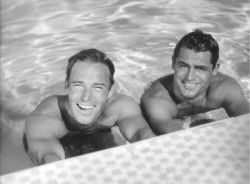
Even though he was famous, Randolph Scott kept his private life quiet. Off-screen, he was good friends with Fred Astaire and Cary Grant. He met Grant on the set of Hot Saturday (1932). For a while, they shared a beach house in Malibu called "Bachelor Hall." In 1944, Scott and Grant stopped living together, but they remained close friends for the rest of their lives.
Randolph Scott died in 1987 at the age of 89 from heart and lung problems in Beverly Hills, California. He was buried at Elmwood Cemetery in Charlotte, North Carolina. He and his wife Patricia were married for 43 years. She died in 2004 and is buried next to him.
Awards and Recognition
In 1975, Randolph Scott was honored at the National Cowboy & Western Heritage Museum in Oklahoma City, Oklahoma. He was inducted into the Western Performers Hall of Fame for his work in Westerns. He also received a Golden Boot Award after his death for his contributions to Western films.
For his work in movies, Randolph Scott has a star on the Hollywood Walk of Fame at 6243 Hollywood Blvd. In 1999, he also received a Golden Palm Star on the Palm Springs, California, Walk of Stars.
Political Views
Randolph Scott was an active member of the Republican Party. In 1944, he attended a large rally in support of the Republican candidates. This event had 93,000 people and included speeches by famous people like Walt Disney. Scott also supported Barry Goldwater in the 1964 presidential election and Ronald Reagan in the 1966 California gubernatorial election.
Radio Appearances
| Year | Program | Episode/source |
|---|---|---|
| 1945 | Screen Guild Players | Belle of the Yukon |
| 1945 | Old Gold Comedy Theatre | A Lady Takes a Chance |
See also
 In Spanish: Randolph Scott para niños
In Spanish: Randolph Scott para niños



